Journal 1 - CAMINA – Community Awakening for Multicultural Integrative Narrative of Almería
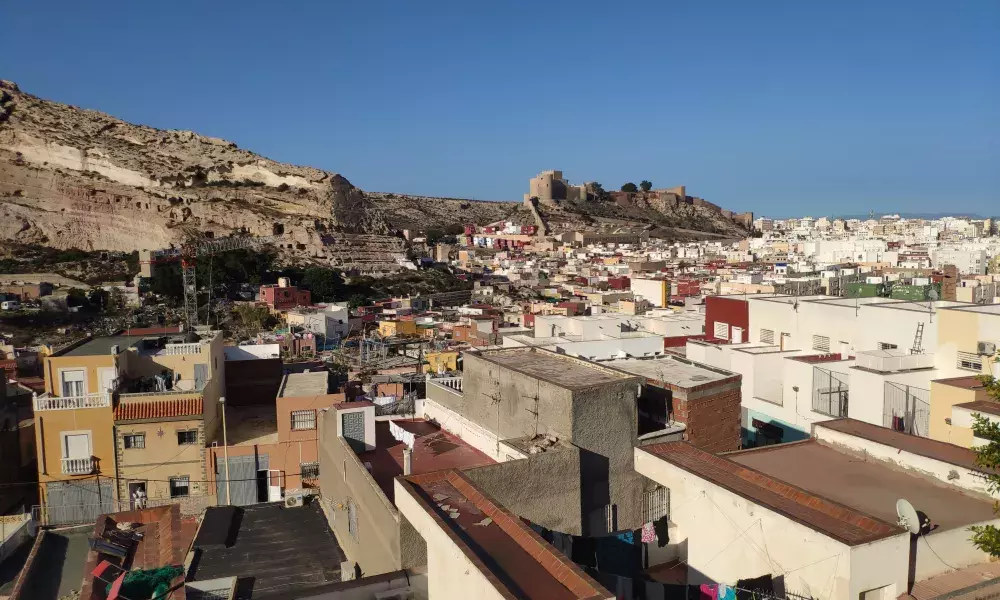
The project “Community Awakening and Multicultural Integrative Narrative of Almería (CAMINA)” is an holistic initiative aimed at rediscovering the values of culture and cultural heritage and its positive effects in the social integration of three deprived neighbourhoods, located in the city centre of Almería, representing the splendour past of the ancient city: Almedina, La Chanca-Pescaderia and the Centre.
CAMINA through a cultural participative approach is aimed at co-creating a Novel Collective Narrative of Almería’s Cultural Landscape through the active participation of experts and citizens living in Almería. The Narrative will design an urban circular route aimed at re-connecting Almedina, La Chanca-Pescaderia and the Centre with the rest of the city, through physical and ICT solutions. It is also the foundation element of the social laboratories for cultural co-designing, so called “civic curators”, uncharged to promote innovative cultural programmes to be realised along the urban circular route and in three “cultural nodes” (Katiuska cinema, Museum Doña Pakyta and Mesón Gitano), located into the three deprived districts, which will become meeting points for the civic curators and cultural hubs for citizens.
Partnership
Almería City Council: https://www.Almeríaciudad.es/
Almería's Provincial Council: https://www.dipalme.org/
Andalucía's Regional Governement: https://www.juntadeandalucia.es/
Ibáñez Cosentino Arts Foundation: https://www.museodeartedeAlmería.com/
Municipal School for Music and The Arts: https://www.emmaAlmería.es/
University of Almería: https://www.ual.es/
KUVER Audiovisual Productions: https://kuverproducciones.com/
EPTISA Engineering: http://www.eptisa.com/
KHORA Urban Thinkers: https://khoraurbanthinkers.es/
Website of the project:
Media contents:
Youtube: https://www.youtube.com/watch?v=xCEXOPIhr-s
Instagram: https://www.instagram.com/Almeríacamina/
Twitter: https://twitter.com/AlmeríaCAMINA_
0. Executive Summary
The First Journal of the project “Community Awakening for Multicultural Integrative Narrative of Almería – CAMINA” analyses the activities progress from July 2020 to September 2021.
The content is based on project documents, online interviews and a study visit held from 21 to 23 September 2021 in Almería. The study visit was an opportunity to meet the partners and participate at the project activities. It allowed also the possibility to walk through the three neighbourhoods of Almedina, La Chanca-Pescaderia and the Centre and get the knowledge of the complex situation due to the vulnerable conditions of residents’ living.
This journal focuses on the specific context of Almería and the targeted deprived neighbourhoods. It provides an overview of the participatory methodologies developed to reach project beneficiaries and co-implement cultural project activities. It also describes how this process has been fit in a wider context such as regional, national or European Level. It also shares the outcomes of the ex ante analysis, as a starting point to lay the foundation of the monitoring system and support the project implementation focusing the attention on the marginalised people living in Almedina, La Chanca-Pescaderia and the Centre.
The chapter 1 sets the scene of Almería, presenting the city context and the challenges of CAMINA. A short description of Almeria history and the problems dealing with the vulnerable conditions of Almedina, La Chanca-Pescaderia and the Centre are introduced.
The chapter 2 describes the local, regional and national context which has favoured the development of CAMINA. A reflection on the role played by the project for Culture and Cultural Heritage at international and European Level is also provided.
The chapter 3 focuses on the project progress. The Cultural Ecosystem Map developed for boosting the participative process in Almería has been described. It has been shaped through a “slow approach”, combining field work with online meetings, to allow the involvement of Almedina, La Chanca-Pescaderia and the Centre residents. A short summary of the outcomes emerged from the Ex Ante analysis is also fitted out: CAMINA foresees a continuous monitoring process which will accompany the project implementation contributing a better development of project activities. The Novel Collective Narrative of Almería’s Cultural Landscape is also presented by sharing the process of co-creation and a brief description on the relevant aspects.
The chapter 4 concentrates the attention on the challenges encountered by CAMINA offering a comment on seven typical challenges for implementation of innovation projects that the UIA Initiative has identified.
The first journal seeks to make an overview of Almeria and the activities developed by CAMINA. But, above all, it aims at sharing emotions, city imagination, expectations, needs offered by the project journey which have the power to trigger the change of paradigm for cultural co-creation and citizens participation, fostering the inclusion of the most marginalised people.
1. Why “CAMINA”? – setting the scene
Historically, the City of Almería lived its splendour when it was “open to the sea”, to people coming from the Mediterranean. This “safe port” has welcomed migrants from North Africa that cohabited with the natives and other ethnic groups such as the Roma people.
The ancient city in front of the sea - the historical city centre of Almería - is nowadays degraded and neglected. The district of Almedina, despite the location – closed to the Centre and the Alcazaba, is a deprived urban area and La Chanca-Pescaderia is in a dreadful state that could be compared to the condition of slum These neighbourhoods, even though being city cultural heritage sites, continue to be phycological divided from the rest of the city and among them, reproducing the walls built during the Muslim era.
Currently, one-third of Almería’s Roma people live in La Chanca-Pescaderia together with migrants and poor urban residents. The people live in Almedina also suffer a risk of exclusion and marginalisation due to the composition of its inhabitants (migrants and Roma), the poor economic situation (as a consequence of city grow in the northeast area and housing depreciation), high rate of unemployed residents and the lack of services and public infrastructures.
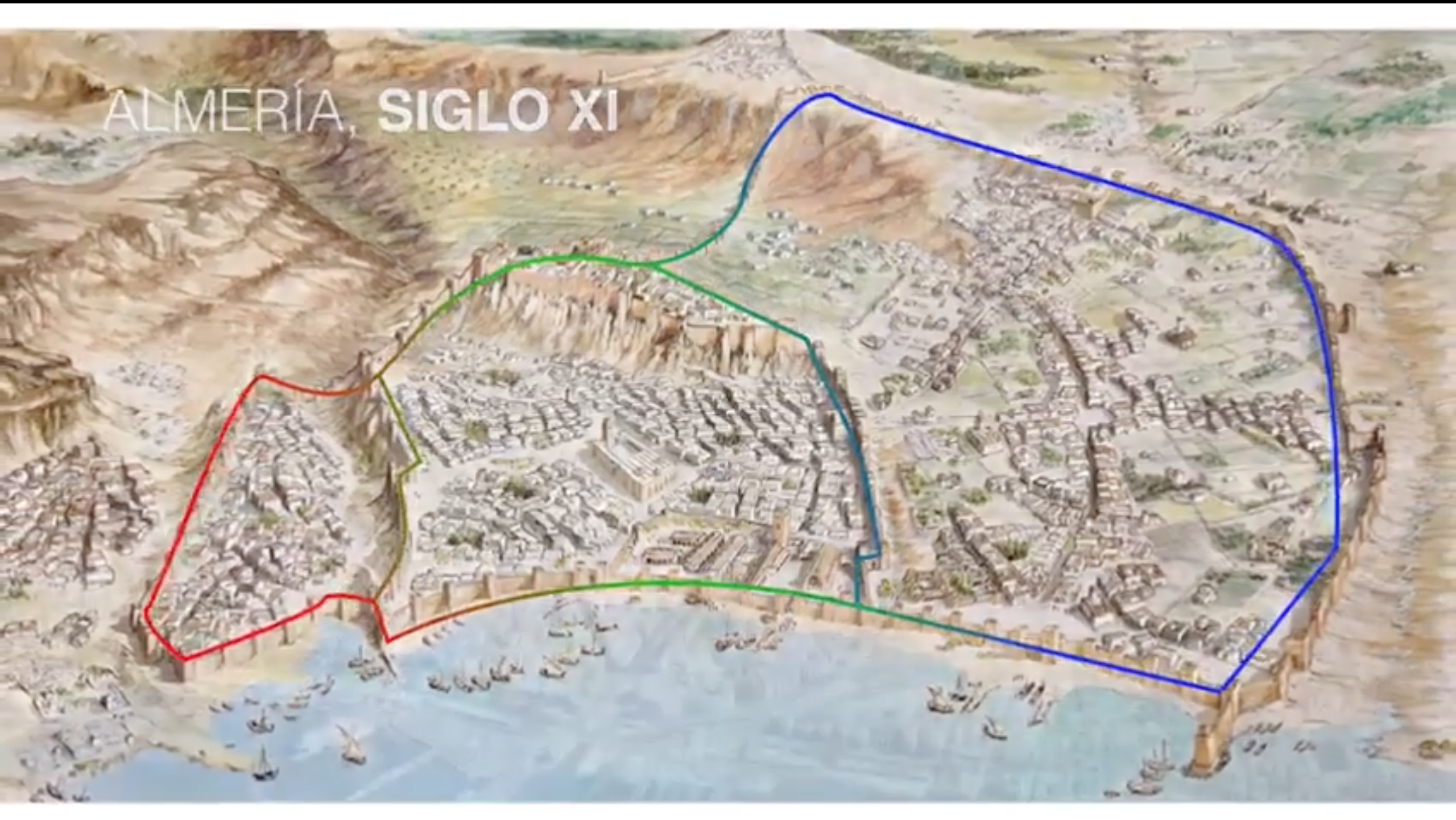
source: screenshot from the promotional video “CAMINA”
Despite the urban poverty conditions of these neighbourhoods and their inhabitants, La Chanca-Pescaderia, Almedina and the Centre have a great potential for their residents and all the citizens of Almería. In fact, those districts represent the history of Almería with its tangible and intangible cultural heritage, that needs to be valorised. The diverse Almería history has led to a long cultural tradition based on different topics around non-material heritage such as flamenco music, marine culture and realism plastic-art. There is also the presence of important cultural heritage especially related to Middle Ages and Al-Ándalus Arab period.
"Almería was the door from the sea in Andalucia. Walls were erected to protect the territory and the neighbourhoods – Almedina, La Chanca Pescaderia and the Centre - from the invasions. In the modern era, these walls don’t exist anymore, but they seem continuing to exist in the head of the people. We want to fall down those invisible walls through the power of culture". Maria del Mar Plaza, general manager of Municipal Corporation Almería 2030
The Municipality of Almería, through the project “Community Awakening and Multicultural Integrative Narrative of Almería (CAMINA)” is willing to promote an innovative cultural participative journey. It aims at involving the three deprived neighbourhoods, with a special attention to marginalised communities, to co-design with them and the local organisations a novel cultural programme for valorising the visible and invisible cultural heritage, reducing the stigma towards people at risk of exclusion such as migrants or Roma and fostering to increase the consumption of culture in Almeria, which is currently very low.
CAMINA through a cultural participative approach is aimed at co-creating a Novel Collective Narrative of Almería’s Cultural Landscape through the active participation of experts and citizens of Almería. The Narrative will design an urban circular route aimed at re-connecting Almedina, La Chanca-Pescaderia and the Centre with the rest of the city, through physical and ICT solutions. It is also the foundation element of the social laboratories of cultural co-designing, so called “civic curators”, uncharged to promote innovative cultural programmes to be realised in the urban circular route and into the three “cultural nodes” (Katiuska cinema, Museum Doña Pakyta and Mesón Gitano), located into the three deprived districts, which will become meeting points for civic curators ad cultural hubs for all the citizens.
2. How the project fits in the policy context at the EU, national, regional level
Almería, through the project CAMINA, has been transformed in a city laboratory to co-create the cultural offer and re-write the city narrative. CAMINA is concretely contributing to a new vision of cultural heritage in the city, putting into practice the objectives addressed by the Almería 2030 Strategic Plan.
Indeed, the idea of the project “CAMINA - Community Awakening for Multicultural Integrative Narrative of Almería” was born during the collaborative workshops set up for writing the Strategic Plan of Almería, so called “Almería 2030”[1]. The plan aims at transforming Almería in a modern, sustainable, developed, accessible, connected, inclusive and diverse place according with the United Nations Sustainable Development Goals (SDGs). It foresees four Strategies dealing with Sustainability, Productive city, Social Inclusion and Culture and Creativity.
The project CAMINA has been contributing to the objectives of Social Inclusion and Culture and Creativity. On the one hand CAMINA is willing to boost a new cultural offer for Almería, focusing the attention on the three historical neighborhoods, La Chanca-Pescaderia, Almedina and the City Centre, currently degraded and with problems of social marginalisation. On the other hand, the project aims at implementing a cultural innovative programme through the engagement of the local communities living in the three neighbourhoods fostering the social inclusion of the marginalised people, the Roma people and migrants and fighting against the prejudice suffered by these target groups.
[1] https://Almería2030.es/el-plan/
“The project CAMINA has been pushing out the Local Institutions from their <comfort zone>. CAMINA has having the power to involve three Local Administrations and several organisations that work on Culture, promoting Cultural events and festivals, but that never have worked together before. This is a change of paradigm at City, Provincial and Regional Level” Maria del Mar Plaza, general manager of Municipal Corporation Almería 2030
The Project CAMINA has been experimenting a sound collaboration between Almería City Council, Almería's Provincial Council and the Andalucía's Regional Government, and the private sectors promoting cultural activities in Almería. The project development based on a permanent participatory process has been feeding the social inclusion programmes and the culture and cultural heritage initiatives promoted at City, Provincial and Regional Level.
CAMINA has been set up as a “city Laboratory for Culture and Cultural Heritage” where Local Institutions can concretely experiment how culture could become a bridge to include the most marginalised communities in the city, fight against prejudice and foster integration.
The project has embedded in the activities the main axes of ESF 2014-2020 dealing with the promotion of social inclusion and the fight against discrimination and social innovation and the Andalucía’s ERDF OP priorities such as promoting cultural and historic heritage, regenerating urban and port areas, improving urban spaces and revitalizing cities through cultural heritage.
CAMINA is aligned with Andalucia’s regional policies regarding immigration which seeks to recognize Andalusian society as diverse -now and in the past- and focuses on how to connect diverse cultures.
Finally, CAMINA is in the front line for providing a contribution from the field to the Spanish national strategy dealing with Social Inclusion of Roma people and de-stigmatization and valorisation of their culture.
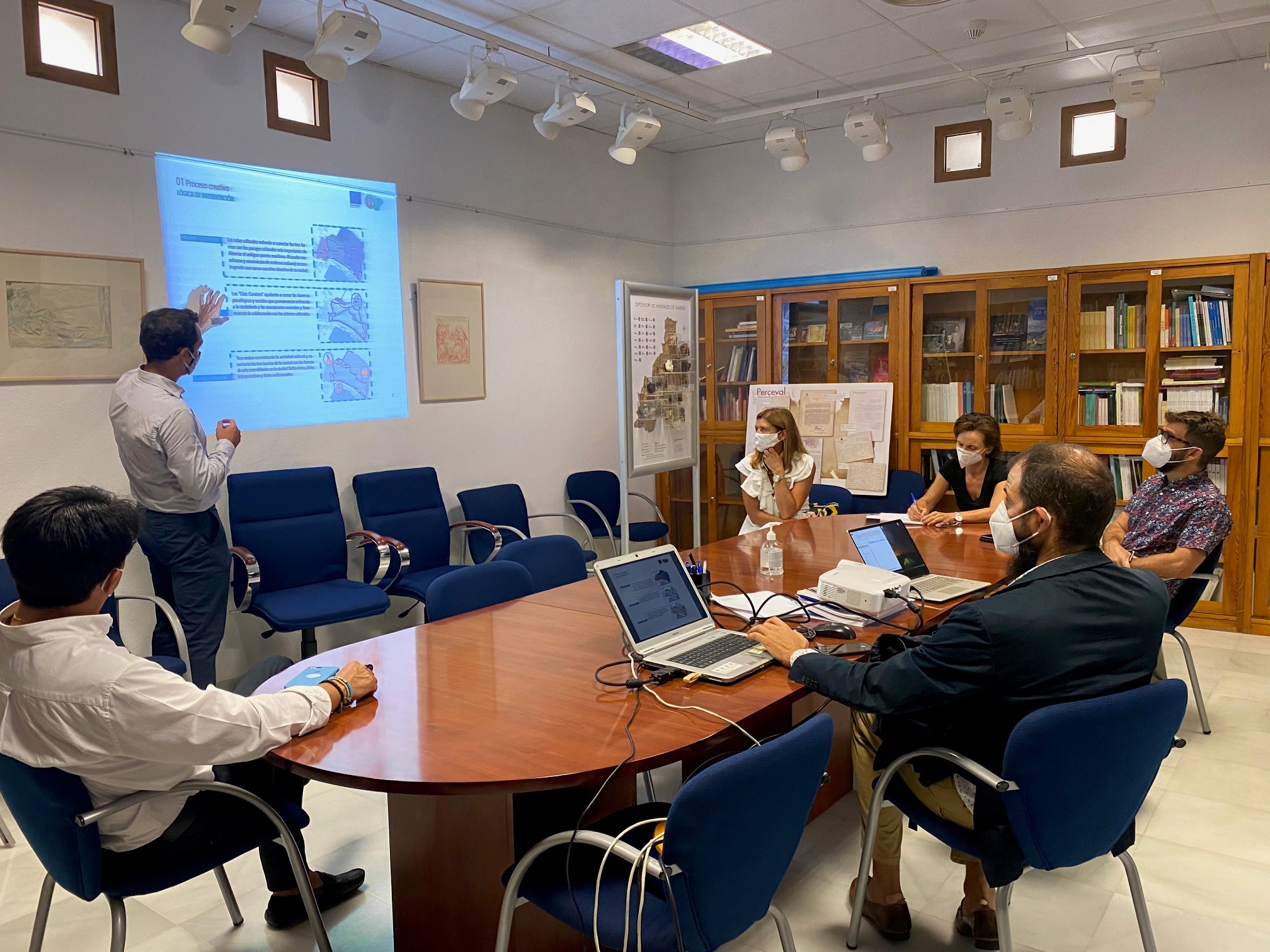
CAMINA has the great ambition to realise in Almería the goal of the New European Agenda for Culture: to increase the cultural participation of citizens, especially focusing on the marginalised vulnerable people generally don’t access the cultural offer in the City.
In Almería, the cultural production is consumed by a small rate of population. The cultural demand is not extensive, and it is usually concentrated on people with the highest level of socio-cultural resources. 70% of citizens prefer watching TV and 50% surfing the internet rather than practising cultural activities (data collected by Almería’s Strategic Plan).
The city of Almería, through the project CAMINA, has the main challenge to open the doors of culture to non- traditional audience (marginalised communities) and allow the access to the heritage sites (La Chanca-Pescaderia and Almedina) for all citizens, that are difficult to visit due to a set of phycological barriers.
But, how to achieve that?
Almería, through the project CAMINA, is trying to realize the paradigm: “if people don’t go to Culture, Culture goes to People”. Indeed, CAMINA, first, has recognised the importance of involving the local cultural organisations, residents and local communities from the design to the realisation of cultural activities. Second, the innovative cultural offer will be realised in the degraded neighbourhoods of Almedina, La Chanca Pescaderia and the Center, through the valorisation of three “cultural nodes” (Katiuska cinema, Museum Dona Paquita and Mason Gitano), with the aim to involve the residents and call citizens of Almería living in other urban areas.
Moreover, the City of Almería and the project partners have been set up a long-term strategy of participation as required by the European Capital of Culture label to include all citizens in benefitting from the cultural offer, with a special attention to those generally excluded - the non-traditional audience.
“The street so called “Avenida del Mar”, which crosses Almedina and La Chanca, is a border for the Citizens of Almería. They don’t feel safe there because there is a problem of stigma. But there is also the evidence that they don’t have a reason to go. And we wish to create opportunities, through Culture, to come in the Center, La Chanca-Pescaderia and Almedina for all the citizens of Almería.”
Maria del Mar Plaza, general manager of Municipal Corporation Almería 2030
The project CAMINA can provide an important contribution at European Level through its inclusive and participative approach for Cultural Heritage to be up scaled in other cities suffering similar problems of marginalisation in cultural heritage areas.
3. Project Update
The project CAMINA officially started on July 2020 with the great ambition to re-launch the Almería Cultural Programme by engaging stakeholders, local organisations, residents, and citizens with the aim to valorise the three historical neighbourhoods of La Chanca-Pescaderia, Almedina and the Centre through an innovative cultural participative process.
But during the first project period the situation dealing with the COVID-19 Pandemic slowed down the project ongoing. The measures of social distance and the impossibility to organise meetings in presence affected the smoothly project implementation. The activities planned for the project beginning were focused on co-creating and co-exploring with potential players the new narrative and building up the “civic curators”. These activities have required face-to-face dynamics and meetings in order to build a proper project environment.
The project activities started through virtual meetings between project partners and local stakeholders and physical one to one meetings. That blended approach allowed to set up the participatory methodology and start the innovative co-creation mechanism forecasted by the project.
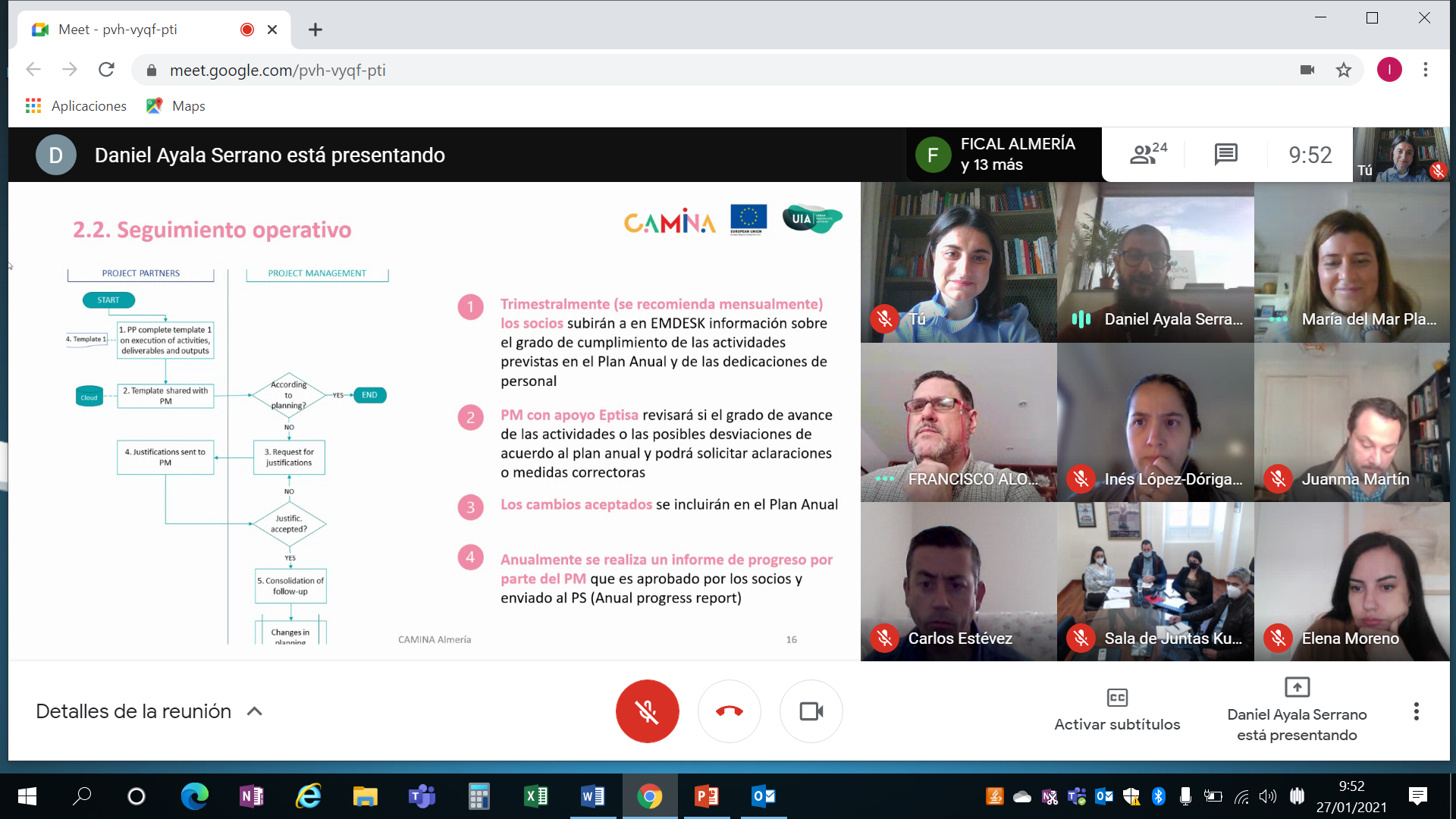
But, the participatory process launched only through digital tools and virtual meetings was not enough effective to actively involve the people live in the targeted areas (La Chanca-Pescaderia, Almedina and the Centre) suffer for marginalisation and digital divide.
Fortunately, since the beginning of the summertime, the Pandemic in all Andalusia decreased, permitting to launch the cultural participatory activities also in presence. That permitted to the local organisations, stakeholders, residents, and citizens to be actively involved in the project development, providing an important contribution for the first project outcomes.
In this project period – July 2020 - October 2021 – the most relevant activities have been:
- The “Cultural Ecosystem map of Almería” to identify cultural organisations, local stakeholders, residents, citizens to involve in the participatory activities;
- The “Ex ante analysis of social integration of the three neighbourhoods - La Chanca-Pescaderia, Almedina and the Centre” to take a picture of the present situation and put the basis for an ongoing assessment of project impact;
- The Co-design process of a “Novel Collaborative Narrative of Almería” through the involvement of history and culture experts and the people of the neighbourhoods - La Chanca-Pescaderia, Almedina and the Centre
A “Cultural Ecosystem map of Almería” based on secondary data (provided by the Almería City Council and Almería's Provincial Council) and field work has been realised by the project partner Khora – Urban Thinkers as a starting point to launch the participatory process. The ambition of CAMINA is to engage with local organisations, residents, citizens, and local communities for re-writing the City Narrative and boosting the regeneration of the three degraded neighbourhoods, La Chanca-Pescaderia, Almedina and the Centre. Building a realistic “stakeholder map – Cultural Ecosystem” of Almería has been an important milestone which allowed to implement properly the project activities.
The Cultural Ecosystem map was drafted firstly through the existing data such as the list of cultural organisations and other formal associations providing culture events in Almería. The Map has been unreached through in person/virtual meetings with relevant stakeholders who shared further contacts of informal organisations delivering cultural initiatives. But it was not enough to design a realistic map of the Cultural Ecosystem of Almería working also for La Chanca-Pescaderia, Almedina and the Centre.
“We realised that we had to go in the street and meet the people face to face. We walked across the three districts for meeting people and listening to them. We get in touch with hairdressers, common people, but also artists. We took coffee or beer with the people living all their life in the neighbourhood. Thanks to that we get the knowledge of many things happenning in Almería, none knows before.” Daniel Ayala Serrano, Khora Urban thinkers
The project partner Khora took the time to stay in the neighbourhoods of La Chanca-Pescaderia, Almedina and the Centre to meet the people living there, promote the project and build a human relationship with the residents. That “slow approach” for triggering the participation of local communities allowed to fill the “Cultural Ecosystem map of Almería”, where there are both formal organisations working on culture and informal groups which organise small festivals, cultural meetings and traditional neighbourhood events. This practice made also possible to identify “Key persons”, who know well the history of the neighbourhoods, their cultural traditions and in some cases, they are also recognised as informal community leaders.
This face-to-face approach has been contributing to build one of the most important elements for “CAMINA”: the trust between local communities and project partners. The strategy of the Local Authorities was to position themselves in the backstage, letting the delivery partners working in the field, to foster a middle out /bottom-up participatory approach.
The relationship built with the people of La Chanca-Pescaderia, Almedina and the Centre has allowed to launch the participatory activities aimed at re-writing the novel narrative of Almería and setting up the civic curators’ groups to co-design the innovative cultural programmes for the three neighbourhoods.
This “slow approach” has favoured a new paradigm of participation for the cultural sector in Almería, meeting the ambition to also include the people of La Chanca-Pescaderia, Almedina and the Centre to become protagonist and not mere spectator of the cultural production in the city.
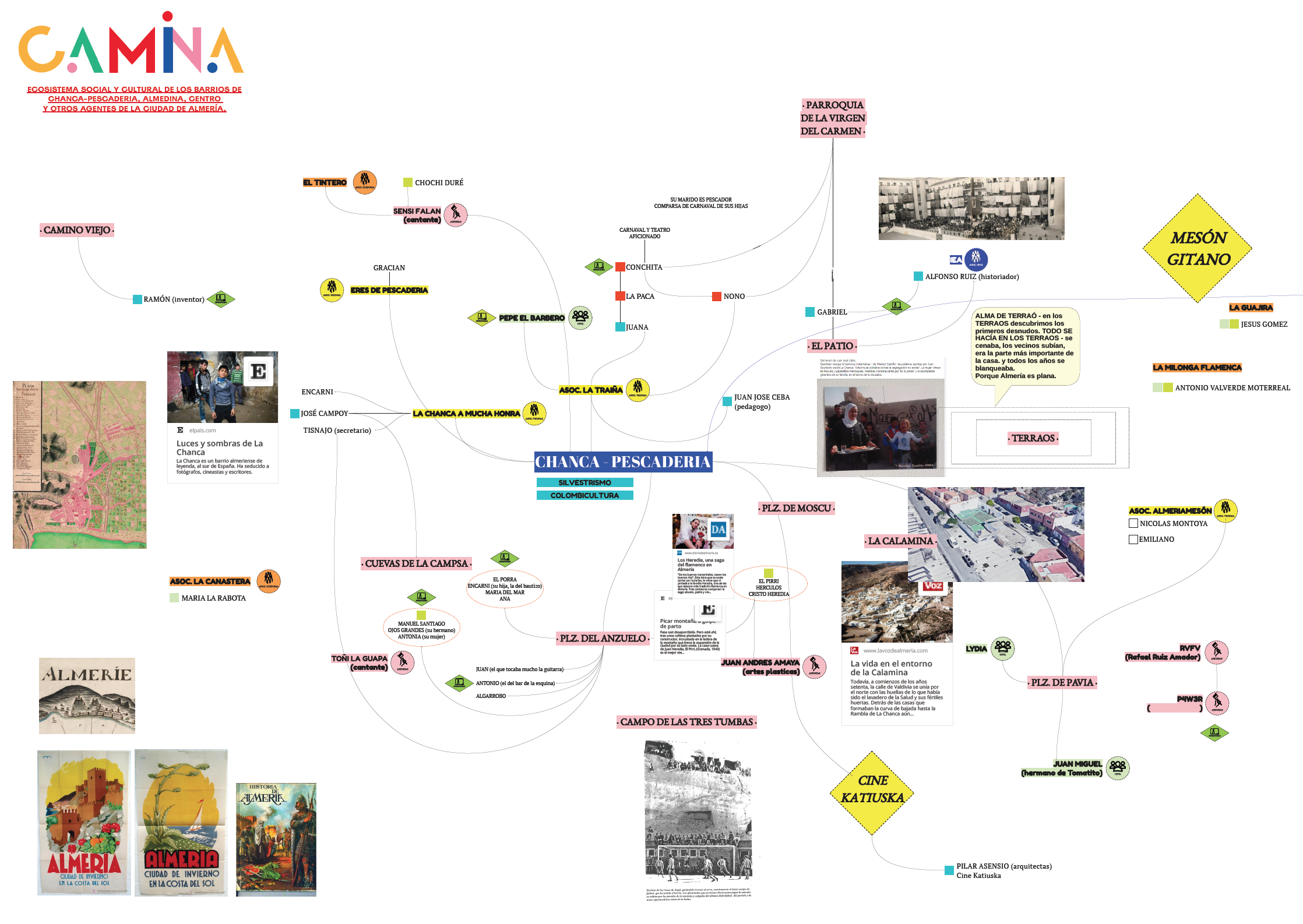
An Ex-Ante Analysis was conducted by the University of Almería project partner to investigate the social integration and the cohesion level in the three districts of La Chanca-Pescaderia, Almedina and the Centre as well as the participation at cultural initiatives.
An online questionnaire was provided to all the citizens of Almería and in particular to those living in the districts of La Chanca-Pescaderia, Almedina and the Centre. it aimed at collecting information dealing with the social integration of the population living in three districts, identification with the symbolic elements of the city and feeling of belonging and participation in cultural activities.
The ex-ante analysis obtained to reach 1112 persons, 171 residents of Almedia-Alcazaba, 168 residents of La Chanca-Pescaderia, 326 residents of the Centre and 447 citizens of Almería live in other districts.
The results are summarised follows:
- The level of social integration and social cohesion is low both in the three districts and in the other city neighbourhoods. The multicultural reality of Almería is considered as a negative aspect by most of the people involved in the survey. The prejudice against Moroccan, South American, Roma people is confirmed and affects the Moroccan people more than others. The negative aptitude against the people of low socio-economic level impacts less than the negative aptitude against the ethnical groups. Despite this overall negative situation and the poor condition of the neighbourhood, the social integration of Roma and Moroccan people in La Chanca-Pescaderia has been observed as a bit more positive than in the other two districts. The Roma and the Moroccan Culture as well as the multicultural dimension of Almería are more accepted in La Chanca-Pescaderia than in Almedina and the Centre.
- The overall consideration about the city of Almería is not positive for its citizens. Aesthetic, feeling of safe, cohesion between neighbourhoods have been ranked as “regular”. The Centre district obtained a better evaluation compared to other neighbourhoods, considering the presence of historical elements and the presence of public spaces. While La-Chanca-Pescaderia has been identified as unsafe, unattractive, and not connected with the rest of the city. The study shows a low level of identification with the symbolic elements of the city and feeling of belonging, except for the residents of La Chanca-Pescaderia, who recognize themselves with the neighbourhood.
- There is a lack of participation in cultural activities for all the citizens of Almería. People prefer joining popular activities in the streets to celebrate Halloween, Carnival, white nights, while attending at Music and Theatre events or visiting Museums or fine arts exhibitions. This situation is particularly grave for La-Chanca-Pescaderia, where there is also a lack of interest in all types of cultural activities.
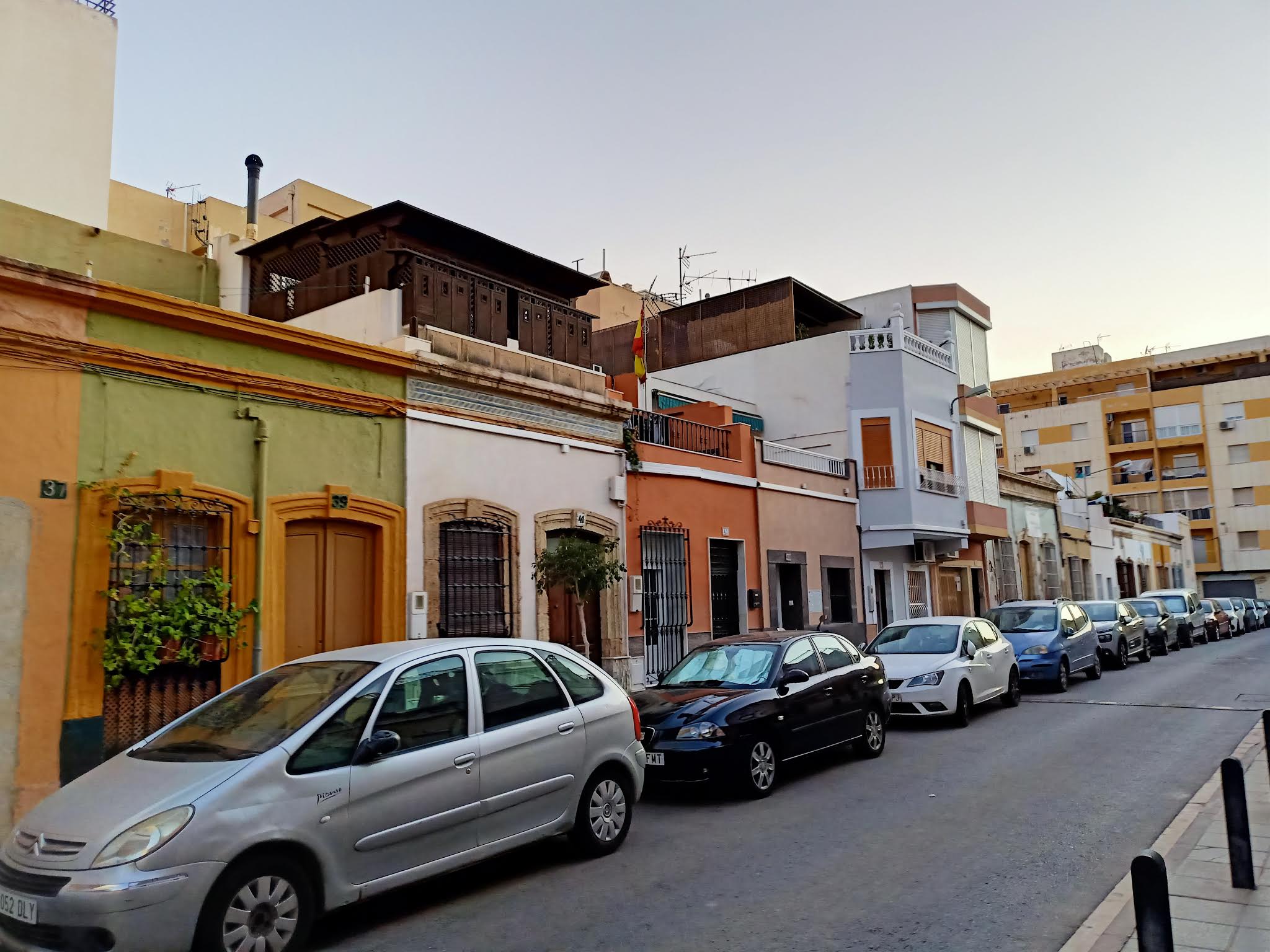
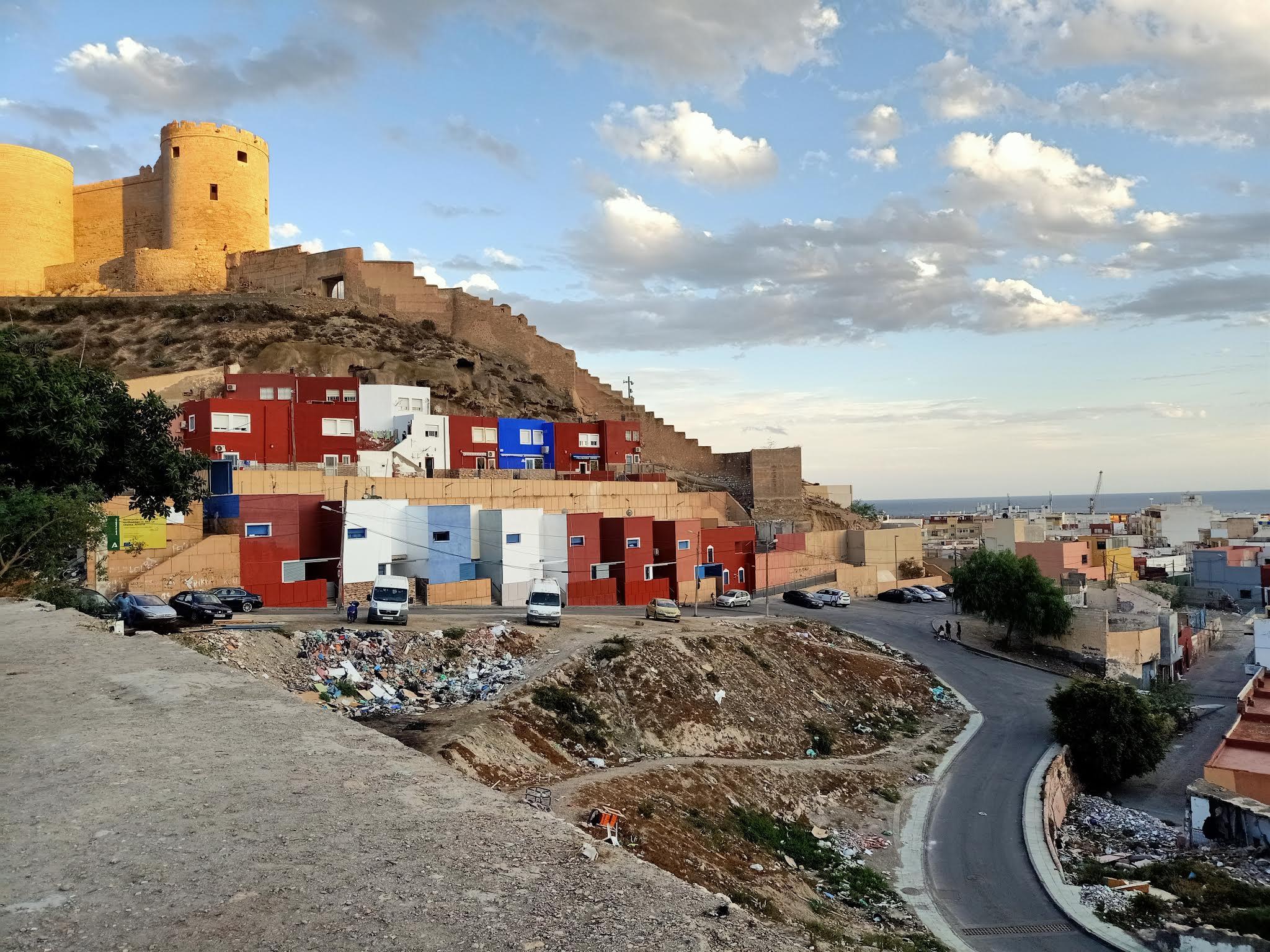
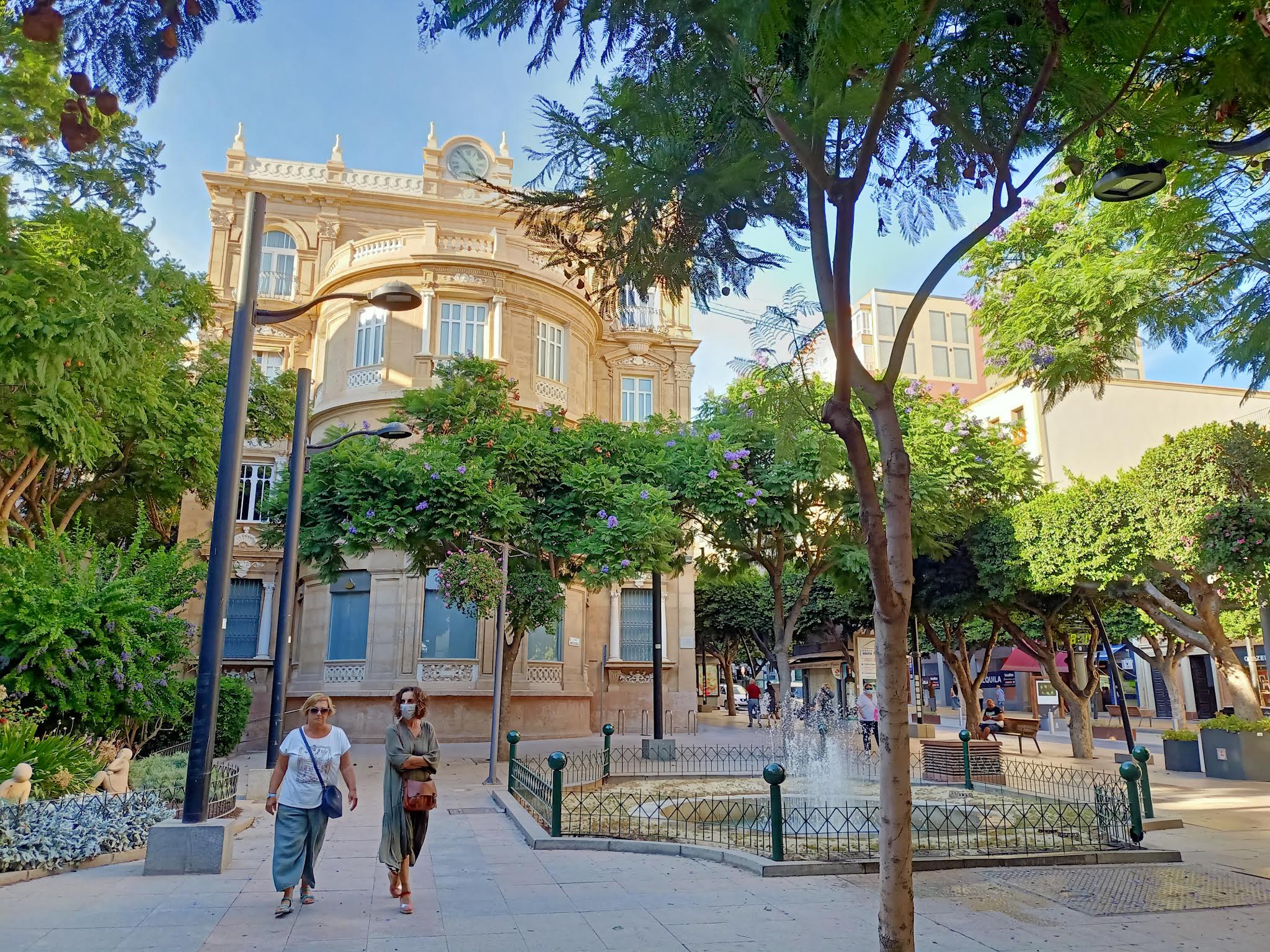
In re-thinking the cultural system, the city of Almería, through the project CAMINA, has fostered the design of a novel city narrative as foundation element to build a bridge between the diverse and multicultural communities living in Almería.
The “Novel Collective Narrative” aims at connecting feelings, needs, people, neighbourhoods, city imagination, future, present and past of Almería to build a common Cultural Landscape.
It was planned by the Application Form that the narrative had to be built through a top-down approach involving history and culture experts. But, from the early stage of the project implementation, the process was changed to allow the inclusion of the people from the ground to contribute at the narrative.
“We realised that the top-down approach couldn’t be thorough to build the Cultural Landscape narrative of Almería. We decided to invert the course. We took the advantage of the contacts collected through the work done for the Cultural Ecosystem and include also common people to collaborate at the narrative. We get inspired from other participative storytelling experiences developed in New York and Detroit so called “Story Bank”. Pablo Macías Bou, Khora Urban thinkers
As a first step, the project partner Khora Urban Thinkers, together with Almería City Council, involved the experts of the “Instituto de Estudio Almeriense”, the historical cultural department of the Almería’s Provincial Council. A series of individual interviews with the experts and focus group workshops were realised, through digital platforms, between October and December 2020.
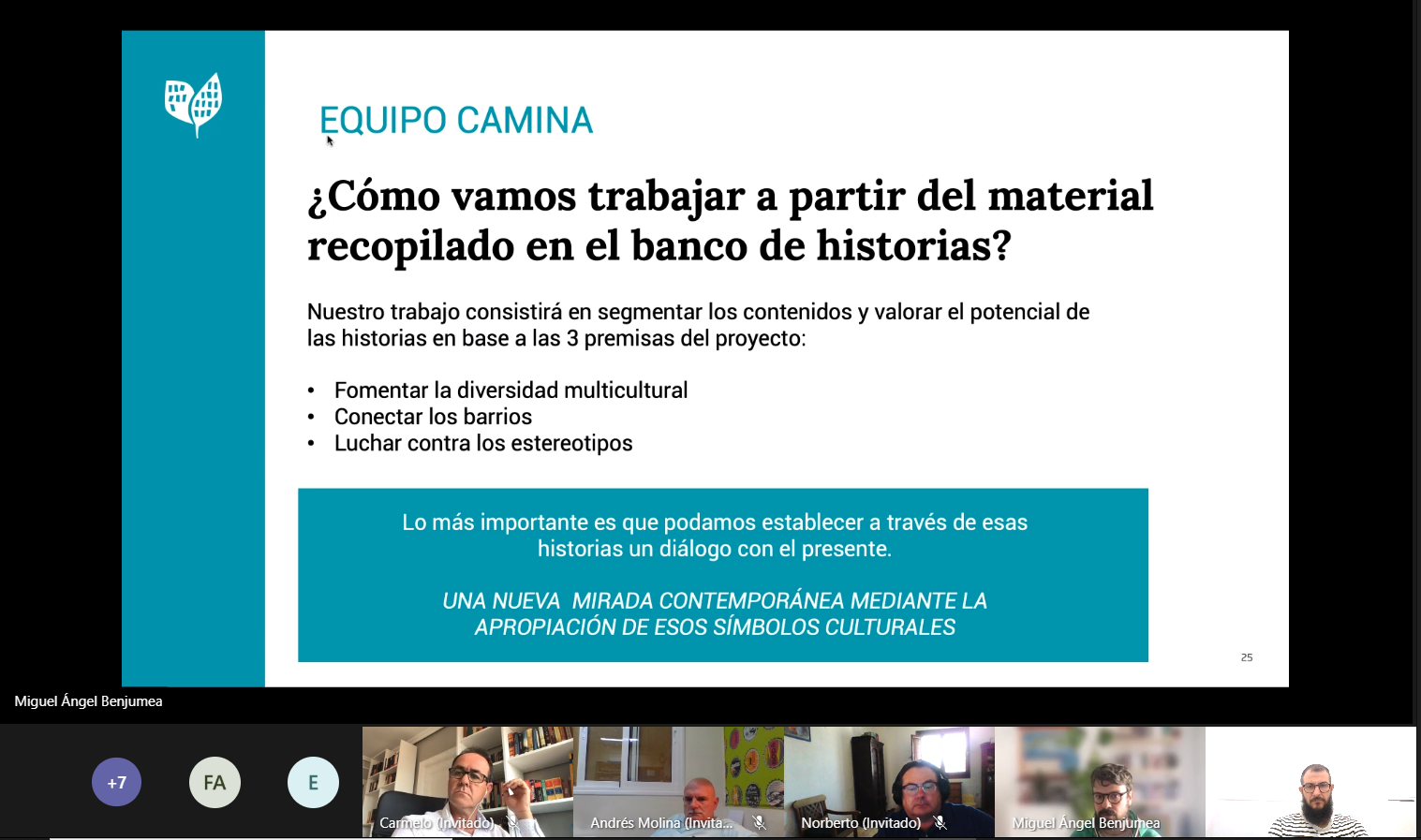
Three themes emerged, representing the cross-cutting statements of Almería’s Civic culture: the Port, that has an important role of economic exchange for Almería, especially with the North Africa, and welcoming different cultures; the Mediterranean Sea, that represents a container of histories, cultures and religions; and the Light, that is a metaphor of life, knowledge and creation belonging to the Christian, Jewish, Muslim and Azteca cultures present in Almería.
Starting from these three statements which represent the collective imagination of Almería shared by the experts of history and culture, it was launched the “Story Bank”, an open call for all the citizens to contribute at the collaborative narrative sharing their own history of life linked to the three statements. The concept of Story Bank[1] could be compared to the “Noah's Ark”, where the cultured stories and the story of life have an equal importance.
Thirty stories have been collected so far allowing the opportunity to start drafting the collaborative narrative which contains the statements and also embraces the vision of past, present and future of the city of Almería. The “Cultural Landscape Storytelling Group” was set up, composed by all the storytellers, both experts and common people. The “Cultural Landscape Storytelling Group”, facilitated by Khora, have been met regularly to share the stories and co-create the Novel Collective Narrative of Almería’s Cultural Landscape.
The Novel Collective Narrative of Almería’s Cultural Landscape focuses on three concepts:
- “Belonging to the same place“. It addresses the cultured and common stories of Almería, through a journey into the past of Almería.
- “The School of the South”. It focuses on city present. It seeks to valorising the skills and competencies of the people living in the South, through a non formal school-education approach.
- “Infinitive Horizon”. It fosters a cultural dialogue with the future opportunities offered to Almería by the Port development, the multicultural communities and the novel urban public spaces.
The Narrative is a milestone for the project CAMINA which lays the foundations to design the cultural circular routes to connect the neighbourhoods of La Chanca-Pescaderia, Almedina and the Centre and inspire the work of the civic curators in shaping the new cultural programme of Almería.
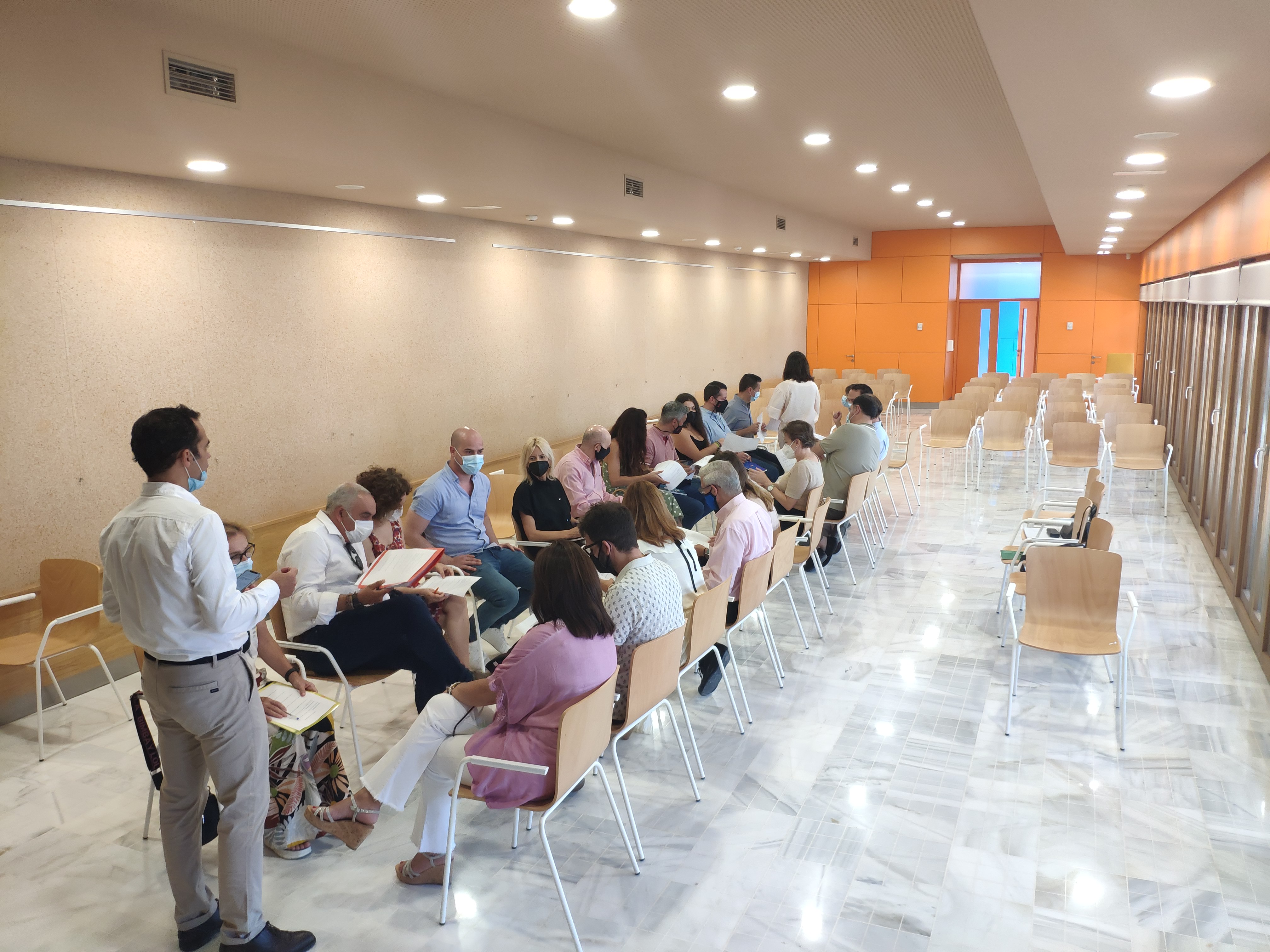
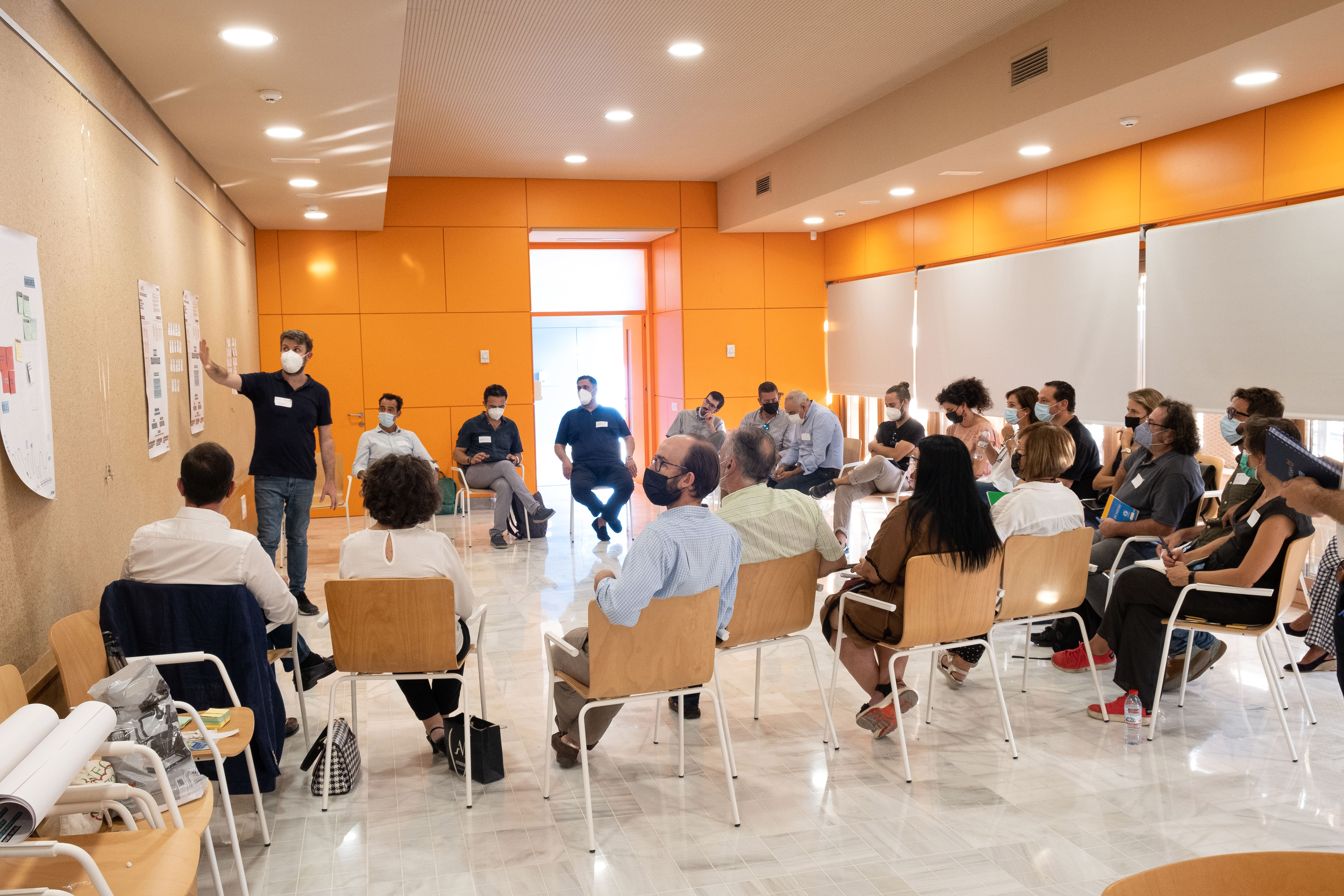
[1] Experiences of Story Bank developed in USA: https://workingnarratives.org/article/story-banks/
4. Implementation challenges
CAMINA has a strong political support. It has been conceived as an implementation activity of the socio-cultural objectives fostered by the Almería 2030 Strategic Plan and followed directly by the Presidency area of Almería City Council. It has been implementing directly by the Municipal Corporation Almería 2030, uncharged to follow the implementation of the Almería 2030 Strategic Plan and with a sound support in the project management provided by the project partners Eptisa, the University of Almería and Khora and through the involvement of other delivery partners.
The project leadership is well recognised by the delivery partners and beneficiaries. But despite the assets, this challenge is somehow relevant due to the innovative approach of CAMINA, that asks to change the way to consider “leadership” for cultural projects. Indeed, the aim of the project is not focused only on investments and cultural events organisation, but on a new approach to co-create culture through the cultural participative approach, where everyone is onboard and has same rights to propose cultural ideas. It requires a more “diffused” leadership to share project responsibility, co-creation and driven. This process is facilitated by the project partner Khora, together with Eptisa, that are working as facilitators to boost the cultural innovation cultural process in Almería.
Two difficulties appeared that slowed down the public procurement process: the COVID-19 Pandemic and the “generacion de credito”. The Pandemic affected the smoothly ongoing of the project, especially the participatory activities that are the foundation element of the CAMINA outcomes. The “generacion de credito” is a municipal bureaucratic process to distribute the economic resources between the municipal departments which took more time than expected.
Despite that, the Municipality of Almería is going to launch in the next weeks two public procurements:
- The public procurement to engage the agency of Communication to support the project dissemination and capitalisation;
- The public procurement to renovate the ground floor of the Museum “Doña Pakyta” (the cultural node located in the Centre) to host fine arts exhibitions and social laboratories.
The most relevant Public Procurements promoted by CAMINA have to follow the outcomes of the participatory process: the Cultural Narrative that allows to design the ”Cultural circular Routes” for La Chanca-Pescaderia, Almedina and the Centre and the Civic Curators works, that co-create novel cultural programme to be realised in the three project nodes (Katiuska, Museum Doña Pakyta and Mesón Gitano). For that reason, it is expected to launch the following procurements as next project steps.
Thanks to the recent experience of co- designing the Almería 2030 Strategic Plan, the Almería City Council has been already used to work in sound collaboration between Different Departments. The co-creation and co-management mechanisms, through a cross department working, have been embedded in the daily work of the Almería Municipality to implement the project CAMINA as well as the other activities forecasted by the Strategic Plan.
The Municipal Corporation Almería 2030 uncharged to coordinate the Strategic Plan and CAMINA, as sub-activity of the Plan, is working in sound connection with the other municipal departments, following the framework set up for the co-creation and realization of the Almería 2030 Strategic Plan. It has a staff that works as facilitator/coordinator inside the municipality providing connections between departments to implement the activities.
“The Municipal Corporation Almería 2030 is the office uncharged to manage the implementation of Almería 2030 Strategic Plan and its forecasted activities, such as CAMINA. It works as an umbrella inside the Municipality. It keeps the connections with all the municipal departments, allowing to work with all the staff of the Almería City Council”.
Maria del Mar Plaza, general manager of Municipal Corporation Almería 2030
CAMINA has been benefitting by the “collaborative structure” built up for designing the Strategic Plan. Eight Thematic groups focused on the SDGs have been created to share insights dealing with visions, ideas, development for Almería. Each group is composed by the people working for the City Council and other local institutions.
This participative cross-cutting methodology has allowed the Municipality to trigger a new collaborative way of work between municipal departments and other local stakeholders.
The participative approach for the co-implementation of project activities is the hearth of the project CAMINA. This challenge is particularly relevant for the project successful and even if the participative methodology for co-realising the project activities is well structured and well implemented so far, the MUA and the delivery partners must continue taking care of this sensitive process, which aims at including also the vulnerable groups of people.
The innovation of CAMINA has been embedded in a wide participatory cultural process which allows to engage with “traditional” stakeholders, such as local associations and NGOs, as well as “unconventional” ones, as vulnerable people living in the deprived neighbourhoods of La Chanca-Pescaderia, Almedina and the Centre.
A Cultural Ecosystem Map of the relevant stakeholders has been built as a “live guide” document, to be fed during the project lifespan, where cultural organisations have been positioned together with common “key people”, that are persons knowing the neighbourhoods. The Map has been guiding the engagement of the people for writing the Cultural Narrative through the “Story Bank” method and to launch the “social laboratories groups” so called “Civic Curators”.
Blended methodologies have been forecasted to tackle the problem caused by the Pandemic. In the first months, digital meetings were organised with project partners and local stakeholders, through a digital collaborative approach. One to one physical meetings were organised between the Municipality of Almería, project partners and relevant stakeholders. Starting from June 2021, it was finally possible organising plenary sessions in presence: focus groups and co-design workshops were realised for co-implementing the project activities such as: the ex-ante analysis, the Collaborative Cultural Narrative and the launch of the Civic Curators groups.
Last but not least, a sound field work in the districts of La Cancha-Pescaderia, Almedina and the Centre was realised with the aim to actively include also the people living there. This work in the streets has been crucial for the project CAMINA. It allowed to include migrants, representants of Roma communities, women and other the marginalised people to be involved in a project concerns them. It was a first step to start breaking the invisible walls of stigma and prejudice built inside the city of Almería.
The Monitoring and Evaluation system developed by the project CAMINA is led by the Municipality of Almería and realised by the delivery partner University of Almería. It has been conceived as a continuous process during the life span project and foresees three different assessment phases: ex-ante, mid-term and ex-post analysis.
The ex ante analysis has been already realised to investigate the social integration and the cohesion level in the 3 districts of La Chanca-Pescaderia, Almedina and the Centre as well as the participation at cultural initiatives.
The results were shared with project partners on 1st July 2021. They focused on the analysis of social integration of population living in three districts, identification with the symbolic city elements, feeling of belonging and involvement in cultural activities (see paragraph 3.3)
This analysis is a milestone for CAMINA as it allows to set up the assessment mechanism to measure the social impact of the project into the three degraded neighbourhoods.
Despite the so well-designed methodology, the challenge is considered somehow relevant due to the difficulties of monitoring the results of cultural projects on the social integration of vulnerable people.
The targeted beneficiaries of CAMINA are the residents of Chanca-Pescaderia, Almedina and the Centre together with all the citizens of Almería. The project has the great ambition to reduce the prejudice against the Moroccan, South American, Roma people living in the three neighbourhoods and foster their inclusion in the cultural city life. The Communication process is fundamental for this achievement and this challenge is considered particularly relevant for the project successful.
On the one hand it is needed to include the people from the ground living in Chanca-Pescaderia, Almedina and the Centre in participating at the project activity. On the other hand it’s necessary to engage with other citizens to come in those neighbourhoods and participate at the cultural offer provided by the three cultural nodes (Mesón Gitano, Doña Pakyta Museum and Cine Katiuska).
The communication with project beneficiaries is the key to achieve that. The project partner Khora promoted a “slow approach” for triggering the participation of local communities through taking the time to stay in the neighbourhoods of La Chanca-Pescaderia, Almedina and the Centre for meeting the people living there and building a human relationship with the residents.
This face-to-face approach has been contributing to build one of the most important elements for “CAMINA”: the trust between local communities and project partners. The strategy of the Local Authorities was to position themselves in the backstage, letting the delivery partners working in the field, to foster a middle out /bottom-up participatory approach.
The people living in the targeted neighbourhoods suffer also for the digital divide and they are not used to communicate via email or participate at virtual meetings. They need a contact face to face or through phone. Among others, it was planned to create a WhatsApp group to keep in touch with all them.
This “slow approach” has been favouring a new paradigm of participation for the cultural sector in Almería, meeting the ambition to also include the people of La Chanca-Pescaderia, Almedina and the Centre to become protagonist and not mere spectator of the cultural production in the city. But, this process requires time and it also needs to be open to other citizens of Almería through a tailored communication campaign.
The design of the cultural participative strategy has been already shaped to allow Almería to aspire up-scaling CAMINA.
The City of Almería and the project partners have been set up a long-term strategy of participation as required by the European Capital of Culture label to include all citizens in benefitting from the cultural offer, with a special attention to those generally excluded by cultural offer and the non-traditional audience. That could allow Almería to make a candidature as European Capital of Culture for capitalising the CAMINA experience.
Moreover, despite being a context specific project, CAMINA could provide important lessons learnt to be applied in other contexts both national and international ones, focused on urban and human regeneration of degraded urban areas through a cultural innovation approach.
5. Conclusion
Almería, through the project CAMINA, has been transformed into a city laboratory to co-create the cultural offer and re-write the city narrative. The project is concretely contributing to a new vision of cultural heritage in the city, putting into practice the objectives addressed by the Almería 2030 Strategic Plan and the European Urban Agenda for Culture. Indeed, the project aims at increasing the cultural participation of citizens, especially focusing on vulnerable people generally don’t access the cultural offer in the city. CAMINA is willing to open the doors of culture to non- traditional audience (the marginalised communities) and allow the access to the heritage sites (La Chanca-Pescaderia and Almedina) for all citizens, that are difficult to visit due to a set of phycological barriers.
For doing that, the project has set up a methodology that recognises the importance of involving local cultural organisations, residents and local communities from the design to the realisation of cultural activities. It has been foreseen to realise the cultural initiatives in the degraded neighbourhoods of Almedina, La Chanca Pescaderia and the Center, through the valorisation of three “cultural nodes” (Mesón Gitano, Doña Pakyta Museum and Cine Katiuska), with the aim to involve the residents and call citizens of Almería living in other urban areas.
A “slow approach” for participation has been developed, which allowed to take the time to stay in the three neighbourhoods for meeting the people and building one of the most important elements for “CAMINA”: the trust between local communities and project partners.
The strategy of the Local Authorities was to position themselves in the backstage, letting the delivery partners working in the field, to foster a middle out /bottom-up participatory approach. Indeed, CAMINA has been pushed out the Local Authorities from their “comfort zone” fostering a new approach to co-design cultural programme through a multilevel governance and a sound collaboration with local organisation and citizens.
Thanks to that, the Novel Collective Narrative of Almeria’s Cultural Landscape has been shaped, through the equal contribution of cultured stories and stories of life. The Narrative is a milestone for the project CAMINA. It lays the foundations for designing the cultural circular routes to connect the neighbourhoods of La Chanca-Pescaderia, Almedina and the Centre and inspiring the work of the civic curators for shaping the new cultural programme of Almería.
CAMINA has been favouring a new paradigm of participation for the cultural sector in Almería, meeting the ambition to also include the people of the three deprived neighbourhoods to become protagonist and not mere spectator of the cultural production in the city.
About this resource
The Urban Innovative Actions (UIA) is a European Union initiative that provided funding to urban areas across Europe to test new and unproven solutions to urban challenges. The initiative had a total ERDF budget of €372 million for 2014-2020.
Similar content




